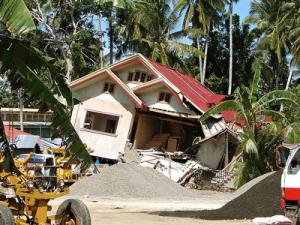EarthquakesThe Philippine islands should brace for the Big One: Scientists
Seismologists say the Philippines should prepare for an 8.5 quake soon. The quake will be triggered by the West Valley Fault, which is a long fault running under six major cities. The scientists estimate the death toll will reach 34,000, about 4,615 kilometers of water distribution pipes will suffer 4,000 points of breakage. Thirty kilometers worth of electric cables will be cut and 95 kilometers of communication cables will be disconnected.

Damage caused by the 2013 Bohol quake // Source: commons.wikimedia.com
Californians have been talking, sometimes jokingly, of the imminent “Big One,” a devastating earthquake on a par, or even exceeding the famed 1906 San Francisco earthquake.
San Francisco was virtually destroyed by the quake, the aftershocks, or by the fires which consumed a great portion of the city. The death toll, estimated to be at minimum 3,000, shocked the city, and the entire country.
The 1906 earthquake is junior level compared to the next major earthquake that is expected to strike the Philippine islands. Because the Philippine islands lie in a region where faults, plates, and trenches surround and pass under the islands, there is a greater chance of a devastating quake. Surrounded as it is by geological features, there is no surprise to seismologists who recognize these features as the cause of the frequency of geological events.
Such powerful earthquakes are not new to the island nation. There is a probability of the Big One having its epicenter along the West Valley fault, which would be devastating to the country, since the West Valley fault passes, under six cities.
The Inquirer.net reports that certain seismological models predict the possibility of another offshore 8.5-magnitude earthquake, a major movement, possibly occurring offshore, that could result in a cataclysm of unheard of proportions.
No one can forecast the date of a quake, but geologists and seismologists can pinpoint the timing of such an event. For the West Valley Fault, seismologists have determined that four major earthquakes have taken place in the last 1,400 years, yielding a recurrence interval of 400 to 500 years.
The last quake to hit the Philippines was is 1990, a 7.8 Richter temblor that killed approximately 1,600 people, and had its epicenter in the town of Rizal.
Since the last major earthquake originating from the West Valley Fault was recorded in 1658, or 357 years ago, we or our children may well witness the next quake.
Along with the power of an earthquake, its duration as a crucial a factor in projecting the expected damage. Since the longer a fault line is, the longer its duration, at least thirty seconds of shaking can be expected in the Philippines.
Such a duration, combined with the fault’s placement under six cities, could cause an extensive amount of damage, and could kill 34,000 people. An estimated 90 percent of those will die, crushed beneath a collapsed building.
The remaining 10 percent of those killed would be the result of fires with the earthquake as first cause. Some would survive initially, but will die soon after, either while getting medical assistance, or remaining unfound under the wreckage.
About 4,615 kilometers of water distribution pipes will suffer 4,000 points of breakage. Thirty kilometers worth of electric cables will be cut and 95 kilometers of communication cables will be disconnected.
There will be widespread confusion and panic when the initial quake occurs, and aftershocks will continue for about a week, and would bring down many of the remaining, weakened buildings.
